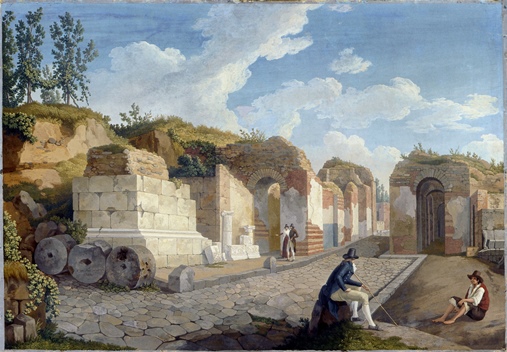/23421.jpg)
/23421.jpg)
The Herculaneum Gate, known in Italian as Porta Ercolano or Porta Herculanea, is one of the seven principal city gates of ancient Pompeii, situated on the northwestern perimeter of the city's walls at the northern end of Via Consolare. This gate served as the primary northern exit from Pompeii, leading along the Via dei Sepolcri (Street of Tombs) toward Herculaneum and further to Naples and Rome via the Via Domitiana, making it a vital artery for trade, travel, and military movement. Historically referred to as the "Salt Gate" (veru sarinu in Oscan or Porta Saliensis in Latin) due to its proximity to nearby salt flats, it exemplifies Roman urban planning and fortification, blending functionality with monumental grandeur. The visible ruins today represent its Flavian-era reconstruction (post-62 CE earthquake), crowning Pompeii's efforts to rebuild and monumentalize its infrastructure before the catastrophic eruption of Mount Vesuvius in 79 CE.
The Herculaneum Gate's origins trace back to Pompeii's Samnite period
in the 2nd century BCE, when the city's walls were constructed using
large tuff blocks in a regular layout, reaching heights of up to 7
meters in some sections. However, the current structure was rebuilt
after the Roman conquest by General Sulla in 89 BCE, during which the
walls and gate bore marks from stone bullets hurled during the
siege—visible scars that highlight its role in the Social War. By the
late Republic and early Empire, the gate's military purpose diminished
as Pompeii became a secure Roman colony, leading to a design focused
more on prestige than defense, lacking robust battlements or towers
typical of earlier fortifications.
A key historical artifact is a
limestone commemorative inscription in Oscan script (dating to the late
3rd or early 2nd century BCE), written from right to left and now housed
in the Naples National Archaeological Museum (inv. 2546/110671, Vetter
9-10). It records the delimitation of the Via Salina (Salt Road) by
aediles P. Matius and Nimsius Maraius, specifying the road's width in
"perticae" (Roman rods of 10 feet), underscoring the gate's early
association with regional commerce, particularly salt trade.
The gate
was severely damaged in the 62 CE earthquake, prompting its Flavian
reconstruction as a triumphal arch-like structure to symbolize recovery
and imperial patronage. Adjacent to the gate was a religious sacellum
(shrine) possibly dedicated to Venus or Minerva, evidenced by votive
offerings like terracotta vases and figurines found near the Tomb of M.
Cerrinius Restitutus, suggesting ongoing cultic practices from Samnite
times through the Roman era. The surrounding area evolved into a
bustling suburban zone, with the necropolis in use from Pompeii's early
centuries (mid-1st century BCE to 79 CE), reflecting social hierarchies
through monumental tombs for elite citizens.

Architecturally, the Herculaneum Gate stands out as Pompeii's most
monumental entrance, resembling a triumphal arch rather than a purely
defensive portal. It features three fornices (arches): a wide central
roadway (approximately 5-6 meters wide) open to the sky for wheeled
traffic like carts, flanked by two narrower pedestrian passageways
covered by barrel vaults. The central vault has partially collapsed, but
the overall design includes an exterior portcullis and an interior
double-leaf gate, forming an open courtyard plan intended to trap
potential attackers—though access to an upper level for defense was
limited, emphasizing its ceremonial over military role.
Constructed
primarily from tuff stone, the gate integrates with the city's
Samnite-era walls, which include a great staircase with tuff steps on
the north side for access to the walkway. To the south, it is flanked by
an inn and stable, while the north features the staircase, rather than
symmetrical parapets as some reconstructions propose. This layout
addressed urban congestion from demographic growth, with wider passages
accommodating increased traffic compared to narrower earlier gates.
Beyond the gate lies the Via dei Sepolcri, lined with the Necropolis of
Porta Ercolano, Pompeii's largest and best-known burial ground. Tombs
here date from the 1st century BCE onward and include diverse types:
semi-circular scholae (benches) for distinguished citizens like the
priestess Mamia (inscribed around 29 CE); altar-shaped tombs on high
podiums, such as that of Naevoleia Tyche and Munatius Faustus with
symbolic ship reliefs; aedicula (small shrine-like) tombs; exedrae
(semi-circular niches); and enclosures with altars. The necropolis
integrates with suburban villas, like the Villa delle Colonne a Mosaico,
blending funerary, residential, and commercial spaces.
Excavations of the Herculaneum Gate began in the 18th century, with the gate itself uncovered in 1763, making it one of the earliest explored areas of Pompeii. The necropolis was excavated between 1763 and 1838, revealing tombs that gained European fame through 1789 publications and early 19th-century drawings, such as those by A. Zuccagni Orlandini (1845) and paintings like "Entrée de Pompei du Cote d’Herculaneum" (pre-1824). Key finds include the Oscan inscription, votive offerings from the shrine, and siege marks on the walls. Archaeologist Amedeo Maiuri (mid-20th century) attributed strata near the Tomb of M. Cerrinius Restitutus to the vanished sacellum. Modern studies, including those by V. Kockel (1983) on grave buildings and conservation efforts documented in works like Kastenmeier (2020), have focused on the gate's environment, including protective coverings for preservation. Historical visits, such as Mussolini's in 1927, are captured in press photos, highlighting its enduring cultural draw.
The Herculaneum Gate holds immense significance as a well-preserved exemplar of Roman gateway architecture from the 4th century BCE fortifications, illustrating the transition from defensive to symbolic structures in a prosperous colony. It reflects Pompeii's social stratification through its necropolis, where tombs served as sites of memory and honor, integrating civic life with the afterlife in Roman tradition. As part of the UNESCO World Heritage Site encompassing Pompeii, Herculaneum, and Torre Annunziata, it provides insights into urban planning, trade routes, and religious practices, drawing scholars and tourists to explore its layered history from Samnite origins to Roman imperial splendor. Today, it remains a highlight for visitors, with ongoing conservation ensuring its legacy amid Pompeii's ruins.